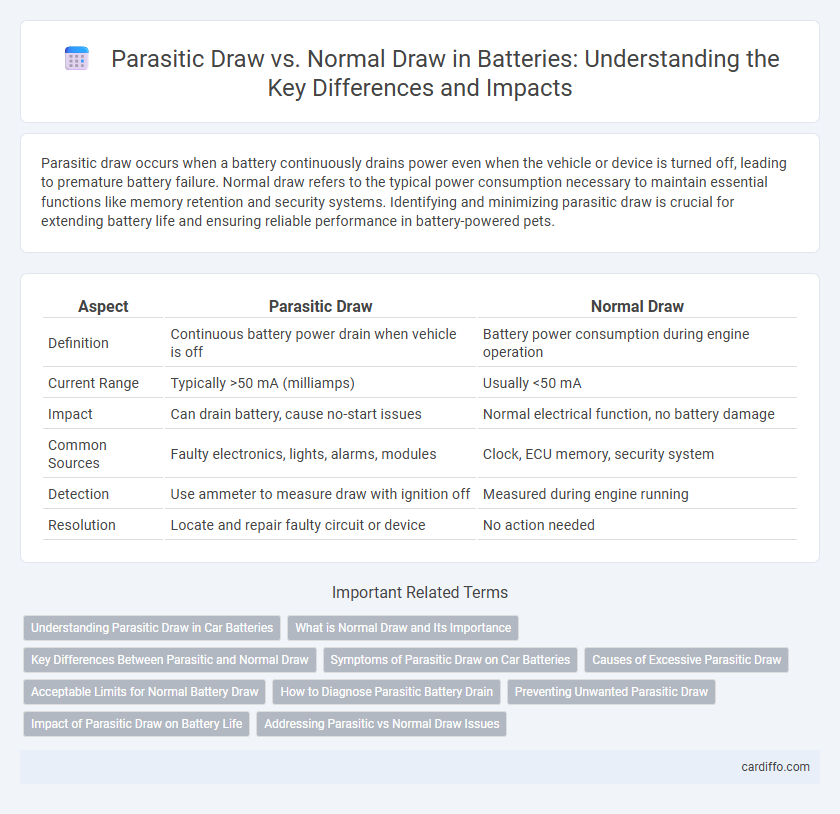Parasitic draw occurs when a battery continuously drains power even when the vehicle or device is turned off, leading to premature battery failure. Normal draw refers to the typical power consumption necessary to maintain essential functions like memory retention and security systems. Identifying and minimizing parasitic draw is crucial for extending battery life and ensuring reliable performance in battery-powered pets.
Table of Comparison
| Aspect | Parasitic Draw | Normal Draw |
|---|---|---|
| Definition | Continuous battery power drain when vehicle is off | Battery power consumption during engine operation |
| Current Range | Typically >50 mA (milliamps) | Usually <50 mA |
| Impact | Can drain battery, cause no-start issues | Normal electrical function, no battery damage |
| Common Sources | Faulty electronics, lights, alarms, modules | Clock, ECU memory, security system |
| Detection | Use ammeter to measure draw with ignition off | Measured during engine running |
| Resolution | Locate and repair faulty circuit or device | No action needed |
Understanding Parasitic Draw in Car Batteries
Parasitic draw in car batteries refers to the continuous discharge of electrical power by components or systems even when the vehicle is turned off, typically ranging from 25 to 50 milliamps as a normal draw. Excessive parasitic draw can drain the battery rapidly, leading to starting issues and potential battery failure. Understanding the distinction between normal draw and parasitic draw helps in diagnosing electrical faults by measuring current flow with a digital multimeter during key-off conditions.
What is Normal Draw and Its Importance
Normal draw refers to the small amount of electrical current continuously consumed by a vehicle's systems, such as the clock, security alarm, and ECU, even when the engine is off. This baseline current consumption is vital for preserving essential functions and ensuring the vehicle remains operational without draining the battery prematurely. Understanding normal draw helps distinguish between acceptable power usage and parasitic draw, which can lead to battery failure if left unchecked.
Key Differences Between Parasitic and Normal Draw
Parasitic draw occurs when electrical components continue to consume battery power even when the vehicle is off, leading to premature battery drain. Normal draw refers to the expected current used by essential systems like the clock, security alarms, and onboard computers during standby mode. The key difference lies in the magnitude and duration of power consumption, with parasitic draw typically being abnormal and significantly higher, causing battery health degradation over time.
Symptoms of Parasitic Draw on Car Batteries
Parasitic draw on car batteries causes symptoms such as a battery that consistently drains overnight or after the vehicle is parked for an extended period. Drivers may notice dimming headlights, slow engine crank, or warning lights on the dashboard indicating low battery voltage. Persistent parasitic draw can lead to frequent jump-starts and eventual battery failure if not diagnosed and addressed promptly.
Causes of Excessive Parasitic Draw
Excessive parasitic draw is primarily caused by electrical components malfunctioning or remaining active when the vehicle is off, such as faulty relays, aftermarket alarms, or interior lights stuck in the "on" position. Corroded wiring and poor insulation can also create unintended current leakage, significantly draining the battery. Regular diagnostics with a multimeter help identify abnormal current draws exceeding the typical 25-50 milliamps of normal parasitic drain.
Acceptable Limits for Normal Battery Draw
An acceptable limit for normal battery draw, also known as parasitic draw, generally ranges from 25 to 50 milliamps (mA) after the vehicle is fully off and all systems enter sleep mode. Values consistently above 50 mA may indicate excessive electrical consumption that can drain the battery prematurely. Monitoring parasitic draw within this range ensures optimal battery performance and longevity.
How to Diagnose Parasitic Battery Drain
To diagnose parasitic battery drain, use a digital multimeter set to measure current and connect it between the negative battery terminal and the disconnected negative cable. Ensure all vehicle systems are turned off and doors closed, then monitor the current draw; a normal draw typically ranges from 25 to 50 milliamps, while anything exceeding 50 milliamps may indicate parasitic drain. Isolate the circuit causing the excessive draw by removing fuses one at a time and observing changes in the current reading.
Preventing Unwanted Parasitic Draw
Preventing unwanted parasitic draw involves regularly inspecting electrical components and disconnecting non-essential devices when the vehicle is off. Using a multimeter to measure current flow helps identify abnormal power consumption exceeding the typical 50mA threshold. Maintaining proper wiring insulation and promptly addressing faulty sensors or modules reduces the risk of battery drain and ensures optimal battery health.
Impact of Parasitic Draw on Battery Life
Parasitic draw refers to the continuous current drain from a vehicle's battery when the engine is off, which can significantly reduce battery life by causing deep discharge cycles and accelerated wear. Normal draw, by contrast, involves minimal current consumption primarily from essential systems like clocks and alarms, posing little risk to battery longevity. Excessive parasitic draw leads to frequent battery replacements and potential starting issues due to insufficient charge retention.
Addressing Parasitic vs Normal Draw Issues
Parasitic draw occurs when electrical components continue to consume battery power while the vehicle is off, exceeding the typical normal draw range of 25-50 milliamps, which can lead to premature battery drain. Diagnosing parasitic draw requires using a multimeter to measure current flow and isolating circuits by removing fuses to identify abnormal power consumption sources such as malfunctioning alarms or interior lights. Addressing normal draw issues involves ensuring all accessories are turned off and that the battery and alternator function properly to maintain optimal battery health and prevent unexpected failures.
Parasitic Draw vs Normal Draw Infographic

 cardiffo.com
cardiffo.com